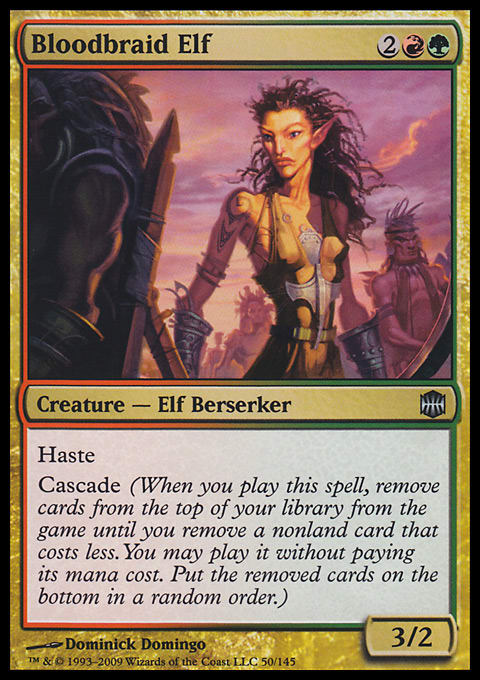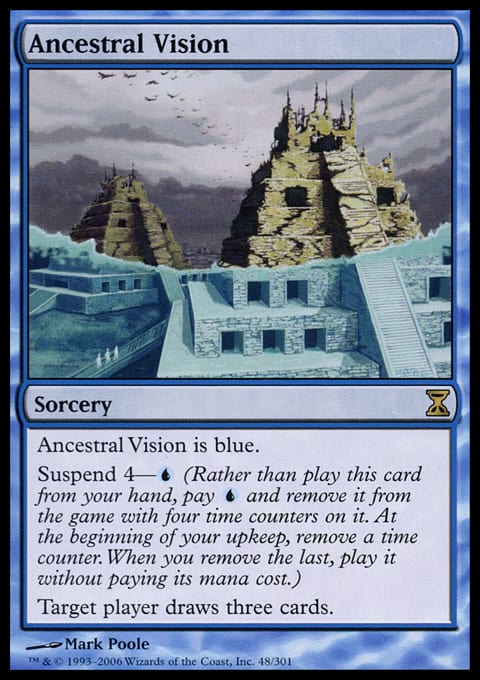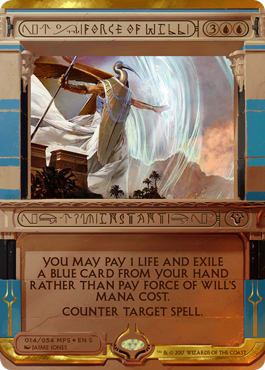Hey there! This week, I will be taking a look at Legacy—to be more precise: a look at the different midrange decks that are present in the format. Legacy has traditionally gravitated toward being more of a fast format, but with recent additions to the format, we suddenly find ourselves in a situation in which we are often playing very grindy matchups.
Midrange started showing up with the printing of Deathrite Shaman and Abrupt Decay. These two cards added a lot of power to the already-potent black and green shell of Dark Confidant and Tarmogoyf. The fact that Deathrite Shaman is an awesome mana-producer has really helped these decks blossom. Maverick, which was perhaps the closest thing to a popular midrange deck before Return to Ravnica, has not been very popular lately. This is probably due to the fact that many of the new midrange decks do some of the same things that Maverick did, only better.
First, I will be taking a look at Jund and then moving on to two different flavors of blue, black, and green. There are some other midrange decks in Legacy as well, but these are the three main archetypes I will be covering this week. One could argue that Esper Stoneblade is also a midrange deck, but it leans a bit more toward control, so I’m skipping it for this article. If you feel that I missed some important deck, be sure to let me know in the comments.
Jund
Jund is among the main reasons we are playing all these games that take more than four turns. It started seeing play in the fall of 2012 and has stayed popular ever since. Here is a sample list played by Michael Bryant to a Top 8 finish at the latest StarCityGames Legacy Open.
"Punishing Jund by Michael Bryant"
- Creatures (15)
- 3 Bloodbraid Elf
- 4 Dark Confidant
- 4 Deathrite Shaman
- 4 Tarmogoyf
- Planeswalkers (4)
- 4 Liliana of the Veil
- Spells (18)
- 2 Lightning Bolt
- 3 Abrupt Decay
- 3 Punishing Fire
- 1 Life from the Loam
- 1 Maelstrom Pulse
- 3 Hymn to Tourach
- 4 Thoughtseize
- 1 Sylvan Library
- Lands (23)
- 1 Forest
- 1 Swamp
- 2 Bayou
- 2 Wooded Foothills
- 3 Badlands
- 3 Bloodstained Mire
- 3 Wasteland
- 4 Grove of the Burnwillows
- 4 Verdant Catacombs
- Sideboard (15)
- 2 Nihil Spellbomb
- 1 Bloodbraid Elf
- 1 Chains of Mephistopheles
- 3 Engineered Plague
- 1 Ancient Grudge
- 3 Pyroblast
- 1 Umezawa's Jitte
- 3 Duress
The creature base is very much standard, with the black and green core of Tarmogoyf, Dark Confidant, and Deathrite Shaman. To complement these, Jund usually plays some number of copies of Bloodbraid Elf, as it is very good in the fair matchups. The spells that you can expect to see from a typical Jund deck are also here. Abrupt Decay, Lightning Bolt, and Punishing Fire serve as the direct removal spells, with Thoughtseize and Hymn to Tourach giving you some chance against combo. Inquisition of Kozilek is a card you often see as well. Most Jund decks run a two-and-two split of Thoughtseize and Inquisition of Kozilek, as taking damage from your own spells can be dangerous in some matchups. Liliana of the Veil is among the cornerstones of Jund and among the most versatile and powerful card in Legacy at the moment. The one-of Sylvan Library and Life from the Loam are additional ways of grinding late-game advantage in those matchups in which you have the time to do so.
The general idea of Jund is to play high-impact spells and win via the card advantage provided by many of the spells in the deck. The Punishing Fire and Grove of the Burnwillows combo can also keep most tribal decks in check as well as handle opposing Deathrite Shamans and Dark Confidants. The combo is also a terrific way of handling opposing planeswalkers.
While Jund is traditionally seen as being favored in fair matchups, it does struggle against combo decks. The clock provided by this deck is not exceptionally fast, meaning your opponent often has time to setup his combo even though you might hit him with one or two disruption spells. Hymn to Tourach is very good, of course, as it can be much harder to recover from than Thoughtseize. Against very fast combo decks like Belcher or the Balustrade Spy deck, there is not much you can do other than pray your opponent doesn’t kill you on the first turn.
B/U/G Cascade
The first of two B/U/G decks I am covering is the cascade version. As the name implies, the deck incorporates Shardless Agent as a way of generating additional card advantage. Here is a sample decklist from Magic Online.
"B/U/G Cascade by obv"
- Creatures (13)
- 2 Baleful Strix
- 3 Tarmogoyf
- 4 Deathrite Shaman
- 4 Shardless Agent
- Planeswalkers (2)
- 2 Jace, the Mind Sculptor
- Spells (22)
- 3 Abrupt Decay
- 4 Brainstorm
- 4 Force of Will
- 1 Maelstrom Pulse
- 2 Hymn to Tourach
- 2 Inquisition of Kozilek
- 2 Thoughtseize
- 4 Ancestral Vision
- Lands (23)
- 1 Bloodstained Mire
- 1 Tropical Island
- 2 Bayou
- 3 Wasteland
- 4 Misty Rainforest
- 4 Polluted Delta
- 4 Underground Sea
- 4 Verdant Catacombs
- Sideboard (15)
- 4 Disfigure
- 2 Duress
- 1 Hymn to Tourach
- 1 Life from the Loam
- 2 Liliana of the Veil
- 1 Maelstrom Pulse
- 1 Nihil Spellbomb
- 1 Tarmogoyf
- 2 Tombstalker
The main engine, if you can call it that, is Shardless Agent and Ancestral Vision. This deck is very good at grinding in the late game, as if you are able to resolve Ancestrals while your opponent is hitting you with one-for-one discard, you are going to end up ahead in the game. This deck then closes out games with Tarmogoyf and Deathrite Shaman. Even though Deathrite Shaman does not seem like much of a clock, when you have two of them out, your opponent will be dead in just a few turns.
This deck fares better against all the unfairness of Legacy, as it has Force of Will to complement all the discard spells. Several combo decks sideboard Leyline of Sanctity, so it is nice to have additional ways of interacting if discard is not an option. This deck really struggles with Blood Moon, as do many of the other midrange decks. Right now is a very good time to be running Blood Moon; I just don’t know which the best deck is for it.
B/U/G
The third deck I am covering is another variation on the B/U/G theme. I’ve been playing with this list online recently and have had a decent amount of success.
"B/U/G Tempo"
- Creatures (15)
- 2 Snapcaster Mage
- 4 Dark Confidant
- 4 Deathrite Shaman
- 4 Tarmogoyf
- 1 Vendilion Clique
- Planeswalkers (6)
- 3 Jace, the Mind Sculptor
- 3 Liliana of the Veil
- Spells (17)
- 1 Dismember
- 2 Spell Pierce
- 3 Abrupt Decay
- 4 Brainstorm
- 2 Inquisition of Kozilek
- 2 Thoughtseize
- 3 Hymn to Tourach
- Lands (22)
- 2 Swamp
- 2 Bayou
- 2 Creeping Tar Pit
- 2 Misty Rainforest
- 2 Tropical Island
- 4 Polluted Delta
- 4 Underground Sea
- 4 Verdant Catacombs
- Sideboard (15)
- 4 Force of Will
- 3 Engineered Plague
- 1 Abrupt Decay
- 1 Thoughtseize
- 2 Surgical Extraction
- 1 Gilded Drake
- 3 Hydroblast
As you can see, the core of this deck resembles the core of both the previous decks quite a lot. This deck leans a lot on the two planeswalkers. I’ve chosen to leave the Force of Wills out of the main deck, as they are not very good in any of the fair matchups, and they are mainly good against combo. If your local metagame is infested with combo decks, I would however urge you to move the Force of Wills to the main deck. Most decks don’t run Snapcaster Mage, but I do like it here, as there are so many good spells to flash back. The one Dismember is very good at getting rid of Deathrite Shaman, Goblin Lackey, and other annoying early drops. Abrupt Decay can sometimes be awkward because it forces you to use your whole second turn to get rid of a problem, whereas Dismember lets you kill the opponent’s creature at end of turn, untap, and drop a creature for yourself.
As for the sideboard, both Engineered Plague and Hydroblast are cards that are mainly there because of the Magic Online metagame, but they do their jobs well. I would like some additional cards for the grindy matchups, but I have not yet really come up with good candidates beside additional copies of Liliana of the Veil and Jace, the Mind Sculptor.
Midrange Over
Of the three decks presented here, I would favor the B/U/G cascade deck if I knew there was a lot of combo, but I would add a bit more discard still. If there are a lot of tribal decks and decks playing small creatures, Jund is a good bet. The last deck is good if you would rather play a bit more controlling with more planeswalkers.
I hope you formed a good idea of the various flavors of midrange that are out there. Grand Prix: Strasbourg is fast approaching, and I have not yet come up with a good deck for the event. I have been testing many decks online, but none have really convinced me.
If you have any ideas, questions, suggestions, or comments, be sure to contact me either via the comments section below or directly via Twitter. I would be interested in hearing from you about what you would like me to write about in the near future.
Thanks for reading,
Max
@thebloom_ on Twitter
Maxx on Magic Online
You can find my music on: http://soundcloud.com/bloomlive

























